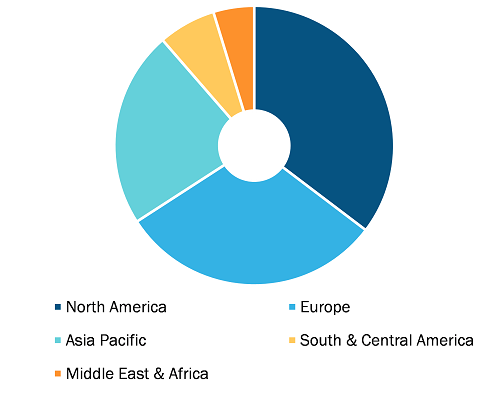Life Sciences Application Segment to Lead Market from 2022 to 2028
According to our new research study on "Microscope Market Forecast to 2028 – COVID-19 Impact and Global Analysis – by Product Type, Application, and End User," the market was valued US$ 12,568.28 million in 2021. It is estimated to grow at a CAGR of 7.3% from 2022 to 2028.
Factors driving the microscope market are the increasing applications of microscopes and the development of novel microscopes. The high price of advanced microscopes may hinder the overall market growth during the forecast period.
Based on application, the microscope market is segmented into material science, nanotechnology, life sciences, semiconductors, and others. In 2021, the life sciences segment accounted for the largest market share. However, the nanotechnology segment is anticipated to grow at the fastest rate during the forecast period. In many life science fields, the electron microscope has contributed in various ways intended for discovering new viruses, preventing infection, clarifying the structure of organelles, drug development, and food safety.
Additionally, life science microscopes such as electron microscopes and scanning transmission electron microscopes are intended for biological research such as cancer cell identification. Various leading competitive players have been involved in manufacturing microscopes intended for biological research. For example, Hitachi High-Tech provides highly advanced microscopes for life-science applications, such as TEM systems, that can be used with ultra-thin sections involved in investigating the internal structure of cells, and standard electron microscope (SEM) and focused-ion beam [(FIB)-SEM] systems for 3D structure observation. Further, the capabilities of microscopes are increasing as manufacturers are developing new laser systems to limit cell damage in biological specimens.
Microscope Market, by Region, 2021 (%)
Microscope Market Size and Forecast (2021 - 2031), Global and Regional Share, Trend, and Growth Opportunity Analysis Report Coverage: By Product Type (Optical Microscopes, Electron Microscopes, and Others), Application (Material Science, Nanotechnology, Life Sciences, Semiconductors, and Others), End User (Industries, Academic & Research Institutes, and Others), and Geography
Microscope Market Trends and Top Players by 2031
Download Free Sample
Source: The Insight Partners Analysis
Impact of COVID-19 Pandemic on Microscope Market
The COVID-19 pandemic significantly affected the global healthcare system. To combat the spread of SAR-CoV-2, governments imposed stringent policies in 2020 and 2021 to prevent and reduce infection and mortality rates. This disrupted and restricted the ability of enterprises to distribute their products and compelled them to shut down their facilities temporarily.
However, according to the Frontiers SA report, electron microscopy acts as a powerful tool in microbiology. The electron microscope has played a key role in the rapid diagnosis of viruses in patient samples that significantly clarified virus structure and function with effective health response to emerging viral infections.
During the COVID-19 pandemic, one of the first methods used for detecting SARS-CoV-2 was electron microscopy (EM). The use of an electron microscope (EM) proved to be a reliable tool for classifying viruses. Also, the high-resolution power of EM contributed significantly to the clarification of viruses' structure and function, playing a key role in the rapid diagnosis of viruses in various samples. Moreover, a scanning electron microscope (SEM) is another powerful tool for microbiological research and diagnosing infectious diseases. SEM has shown advantages over transmission electron microscope (TEM) for studying SARS-CoV-2 and has proven to be a rapid and effective tool for studying the SARS-CoV-2 infectious cycle in Vero cells. Thus, the utilization of the microscope has accelerated during the COVID-19 pandemic.
Moreover, the clinical electron microscope application has been confirmed to be influential in research on the SARS-CoV-2 virus, starting from identifying vaccine candidates to analyzing the SARS-CoV-2 spike. Additionally, the utilization of microscopes increased in research labs and academic institutions that are working on studying viruses, cells, and proteins at the molecular level. Therefore, the demand for microscopes was accelerated due to research and development during the COVID-19 pandemic.
ZEISS GROUP, Bruker Corporation, Leica Microsystems, Nikon Corporation, Hitachi High-Tech Corporation, Olympus Corporation, ACCU-SCOPE, Thermo Fisher Scientific Inc., Euromex Microscopen bv, Oxford Instruments, COXEM Co. Ltd, KLA Corporation, and UNITRON are among the leading companies operating in the microscope market.
Based on the product type, the microscope market is segmented into the global microscope market is segmented into optical microscopes, electron microscopes, and others. The optical microscope segment is sub-segmented into confocal, stereo, digital, and others. Further, the electron microscope segment is bifurcated into scanning and transmission electron microscopes.
Based on the application, the market is segmented into material science, nanotechnology, life sciences, semiconductors, and others. Based on end user, the market is segmented into industries, academic & research institutes, and others. Based on geography, the microscope market is segmented into North America (the US, Canada, and Mexico), Europe (the UK, Germany, France, Italy, Spain, and the Rest of Europe), Asia Pacific (China, Japan, India, Australia, South Korea, and the Rest of Asia Pacific), the Middle East & Africa (the UAE, Saudi Arabia, South Africa, and the Rest of the Middle East & Africa), and South & Central America (Brazil, Argentina, and the Rest of South & Central America).
Contact Us
Phone: +1-646-491-9876
Email Id: sales@theinsightpartners.com